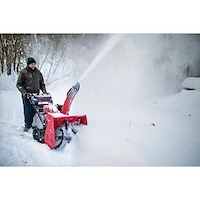
Individuals can prevent common injuries and even death by following these snow blower safety guidelines.
Meteorologists are predicting an El Niño weather pattern this winter. What that spells out for particular regions of the country remains to be seen, but when snow hits certain areas hard, cleanup will be necessary.
It is essential for homeowners and business owners to get outdoors promptly to remove snow from walkways for the safety of pedestrians. Shoveling snow can be back-breaking work, particularly when the snow is very wet or compacted. That's why many people have invested (or plan to invest) in snow blowers to make faster work of snow removal. While these tools are quite effective, they require caution and proper technique to help avoid injuries. The Consumer Product Safety Commission estimates there are 5,740 hospital emergency room-related injuries associated with snow blowers each year. The organization Safety Now says most injuries associated with snow blowers involve injuries to the hands or fingers, including amputation.
Individuals can prevent common injuries and even death by following these snow blower safety guidelines.
· Read the owner's manual to understand all of the controls and features before use.
· Dress accordingly for the weather, including using sturdy footwear with good traction. Boot or shoe grippers can reduce the risk of slips and falls. Also, avoid loose clothing, as scarves or jackets can become tangled in moving parts of the machine.
· Start the snow blower outside and not in a garage or shed. Gas-powered devices give off carbon monoxide.
· Stay focused on the task at hand, which means using the snow blower only when sober and not under the influence of medications that can cause drowsiness.
· Working at a brisk pace can help prevent the snow blower blades from getting clogged from the snow sticking. Wet, heavy snow is more likely to clog the machine, so it may require more passes to get the job done.
· Clogs can occur, and require extreme caution to dislodge. Always turn off the snow blower and disengage the clutch, says the American Society for Surgery of the Hand. Wait for the impeller blades to stop spinning. Always use a broom handle or a stick to clear compacted snow. Never stick your hand down the chute or around the blades, even if the power switch is off.
· Keep all safety shields and mechanisms in place on the machine.
· Do not leave a snow blower unattended.
· If the snow blower is an electrical version, use an extension cord designed for outdoor use and plug it into an outlet equipped with a ground fault circuit interrupter. Keep the extension cord away from the auger.
Even though snow blowing can be less physically taxing than manually shoveling snow, it still exerts the body. Take frequent breaks to rest. Exercise caution where you toss the snow, and make sure other people, particularly children, are not in the path of snow removal.
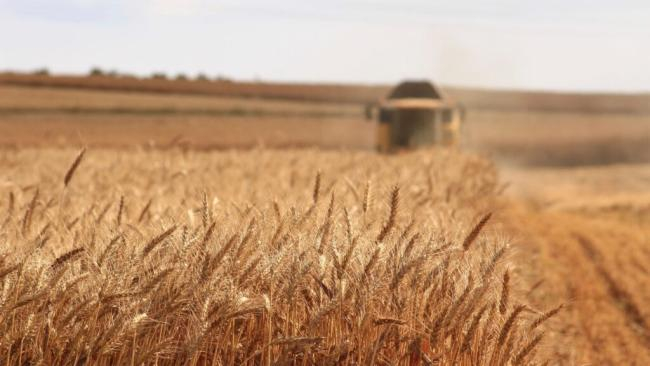
The Southern Region Soil Health Workshop will take place on February 4 in Salem. This is a half day event, with registration beginning at 8 a.m. and concluding with lunch. The workshop will begin at 8:30 a.m.
Monte Bottens, a fifth generation Illinois crop and livestock farmer who will speak on “Soil Health & Virtual Fencing: Improving Grazing and Input Management on Cropland.” A panel made up of Southern Indiana farmers will discuss “Experiences Grazing Cover Crops in Southern Indiana.” Danielle Walker, Ag & Natural Resource Educator with Washington County Purdue Extension will speak on a Private Applicator Regulatory Topic (PARP).
Advance registration for the event is required by January 29 and can be completed by contacting the Washington County SWCD at (812) 883-3006, extension 3 or by registering online Here. The workshop will take place at Cornerstone Hall (1500 RC Morris Drive, Salem). PARP Credits available. CCH and CEU Credits have been applied for. Indiana Corn Marketing Council and Indiana Soybean Alliance through their checkoff dollars are sponsoring private applicators by offsetting their PARP fees. Questions about advisor credits may be directed to Danielle Walker at (812) 883-4601.
The workshop is organized by the Washington County Soil and Water Conservation District (SWCD), the United States Department of Agriculture – Natural Resources Conservation Service (USDA-NRCS), Purdue Extension-Washington County, Indiana State Department of Agriculture and the Conservation Cropping Systems Initiative (CCSI), the South Fork-Blue River Watershed Project, and the Twin Creek-Lick Branch River Watershed Project. The SWCD and partners are equal opportunity providers and accommodations for those who need them will be provided; simply contact the SWCD at (812) 883-3006 ext. 3 at least 14 days prior to the event.

|
||||||||||||||||||||||||||||||||||||||||||||||||||||||||||||||||||||||||||
|
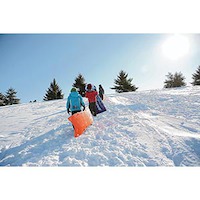
People can follow these sledding safety tips to reduce the risk of sledding injury.
Winter weather is welcomed by some and loathed by others. Some want to hibernate until the mercury rises and the warm sun returns, while others relish in the crisp air, fluffy snow and the absence of insects.
Wintertime activities are numerous and include everything from ice hockey to snowshoeing. However, nothing beats an afternoon of sledding for active families. Believe it or not, the first sleds traveled on sand instead of snow. Historians say the earliest evidence of sledding dates back to ancient Egypt, where carved rock sleds were used for convenience and labor needs. But it was Russian aristocrats who created the first recreational sledding events in the 1650s. Youth would carve large blocks out of ice and traverse hills on wooden tracks. Eventually more modern sleds were used on snow directly, and children from all social classes and around the globe got their thrills from downhill adventures.
On snowy days, scores of children and their parents often take to neighborhood hills to test their sledding skills and feel the breeze blowing by. While sledding can be exciting, it also has the potential to be dangerous. People can follow these sledding safety tips to reduce the risk of sledding injury.
· Pick a safe sled that has brakes and can be steered. Make sure that all sledding equipment is in good condition.
· Choose gently sloping hills with a level run-off at the end so the sled can safely come to a stop.
· Avoid hills with obstacles, such as rocks and trees.
· Sledding participants should always wear helmets.
· Always sled feet-first. Going down a hill head-first is a recipe for serious injury.
· Do not sled around ponds, streams or lakes that appear frozen. They may not be solid and drowning or hypothermia can occur if sledders enter the water.
· Dress warmly and wear thick gloves or mittens and heavy boots. This clothing can protect against frostbite and injury.
· Avoid hills that end near a street or parking lot.
· Everyone should go down the hill one at a time with only one person riding on the sled. The only exception is for adults with young children.
· Don't ever pull a sled with a moving vehicle like a snowmobile or all-terrain vehicle.
· Sled only during the day or in well-lit areas at night.
Sledding is an entertaining activity this time of year. All sledders should keep safety in mind before hitting the hills.

Carol Johnson, Southern Indiana Business Report
ORLEANS – Five months after breaking ground on the first phase of the Monon South Trail, the Indiana Department of Natural Resources and Radius Indiana celebrated the completion of the first phase section of Phase 1A Thursday.
The 1.27-mile multi-use trail extends from Stetson Street to Freeman’s Corner in Orleans. Of that mileage, 1.18 miles of the trail surface is asphalt, and 0.09 miles is crushed aggregate. The project includes a new trailhead at Franklin Street with vehicle parking, a restroom, bike racks and other trailhead amenities.
The segment is the first of five to open in Phase 1 of the Monon South project. In total, Phase 1 will build 20 miles of trail, including segments in Borden, New Pekin, Salem, Campbellsburg, Saltillo and Mitchell.
A crowd of about 100 attended the ribbon-cutting ceremony that included speakers from Radius Indiana, DNR, Cook Group, the town of Orleans, city of New Albany and the project teams of Clark Dietz and Taylor Siefker Williams.
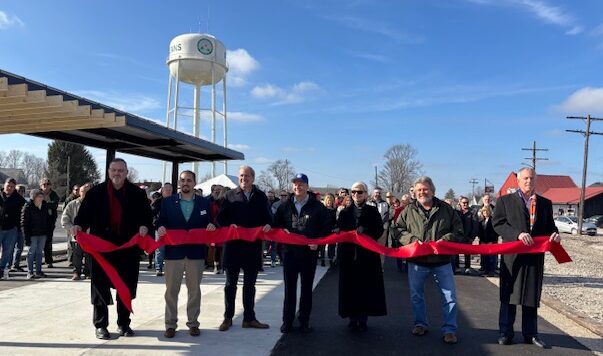 https://southernindianabusinessreport.com/wp-content/uploads/2024/12/IMG_1341-e1734639366412-300x177.jpg 300w, https://southernindianabusinessreport.com/wp-content/uploads/2024/12/IMG_1341-e1734639366412-150x89.jpg 150w" alt="" width="603" height="356" class="wp-image-7805 td-animation-stack-type0-2" style="width:473px;height:auto" decoding="async" />
https://southernindianabusinessreport.com/wp-content/uploads/2024/12/IMG_1341-e1734639366412-300x177.jpg 300w, https://southernindianabusinessreport.com/wp-content/uploads/2024/12/IMG_1341-e1734639366412-150x89.jpg 150w" alt="" width="603" height="356" class="wp-image-7805 td-animation-stack-type0-2" style="width:473px;height:auto" decoding="async" />“The development of the Monon South Trail will be a game changer for attracting massive interest in outdoor recreation across this five-county region in southern Indiana, connecting locals and visitors alike to these communities and the many attractions available along the way,” said Dan Bortner, DNR director. “With the opening of this first section of Indiana’s future longest recreational trail, we’re blazing new trails while preserving history and sparking new economic opportunities.”
Fred and Laura Keller drove down from Martinsville to be among the first to ride on the trail. Avid bicyclists, they prefer riding on rails that have been converted to trails for safety reasons and ride two or three times a week in good weather.
“We’ve been waiting for this,” Fred said. “We see this as a great opportunity to stay safe. This section in Orleans is beautiful and we can’t wait to ride on it when the sections get longer.”
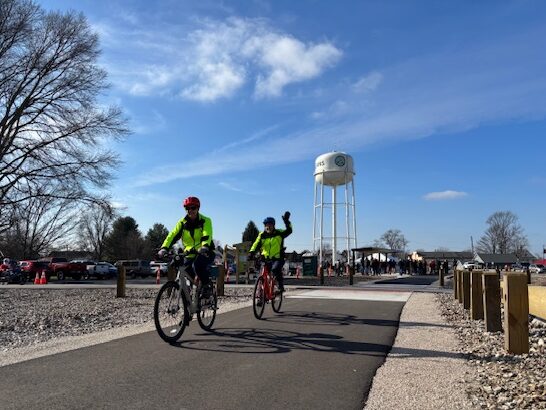 https://southernindianabusinessreport.com/wp-content/uploads/2024/12/IMG_1379-e1734639464171-300x225.jpg 300w, https://southernindianabusinessreport.com/wp-content/uploads/2024/12/IMG_1379-e1734639464171-150x113.jpg 150w" alt="" width="546" height="410" class="wp-image-7804 td-animation-stack-type0-2" style="width:436px;height:auto" decoding="async" />
https://southernindianabusinessreport.com/wp-content/uploads/2024/12/IMG_1379-e1734639464171-300x225.jpg 300w, https://southernindianabusinessreport.com/wp-content/uploads/2024/12/IMG_1379-e1734639464171-150x113.jpg 150w" alt="" width="546" height="410" class="wp-image-7804 td-animation-stack-type0-2" style="width:436px;height:auto" decoding="async" />Bob Templeton made the trip from Bloomfield and brought his recumbent tricycle. Dressed in a Santa Claus T-shirt and Santa hat, he said he wanted to be among the first to ride the Orleans section.
“My wife and I travel around to different trails and it’s nice to have one this close to home,” Templeton said.
Orleans Town Clerk-treasurer Robert Henderson likened Orleans having the first trail opening to an early Christmas present.
“This is a very exciting day for all of us in Orleans,” Henderson said.
The first train to come through Orange County arrived in Orleans in 1851. Rail transportation continued to grow and at one time, 22 passenger trains stopped in Orleans every day, Henderson said.
“Orleans is very proud of its rich link to this corridor and to have eight miles of this incredible Monon Trail as part of our own community,” he said. “We can’t wait to see what the future holds.”
Rail line history
The Monon South corridor follows a road survey commissioned by the Indiana Internal Improvements Act of 1836. In 1847, the Indiana General Assembly authorized a private railroad to build upon the route, and Gov. James Whitcomb signed a proclamation chartering the New Albany and Salem Railroad. By 1854, the railroad was complete from New Albany to Michigan City. In 1956, the railroad officially adopted the iconic Monon Railroad name.
CSXT, a successor to the Monon Railroad, last operated trains on this section of the line in 2008 and abandoned the rail line in 2018. Under a process known as railbanking, New Albany and Radius petitioned to negotiate with CSXT to acquire the out-of-service rail corridor for use as a recreational trail.
Next Level Trails funded the purchase of the 62.3-mile corridor on behalf of New Albany and Radius Indiana for the combined sum of $5.5 million. DNR granted Radius with an additional $22.3 million to support development of the 20 miles in Phase 1. New Albany will own and manage the portion of the trail in Floyd County and Radius Indiana will be responsible for the trail in Clark, Washington, Orange and Lawrence counties.
“The public support for this project has been positive and overwhelming. We’re so pleased that the Department of Natural Resources, the city of New Albany and Cook Group have been strong partners in the development of the Trail,” said Jeff Quyle, president and CEO of Radius Indiana. “Without their collaboration, we would not have been able to open this first segment of the Trail in 2024! We look forward to a busy 2025 as we open several more portions of the Trail and begin to activate it for the public.”
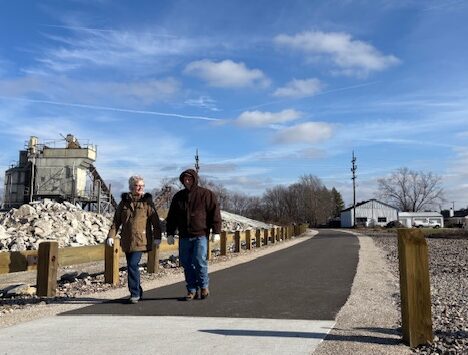 https://southernindianabusinessreport.com/wp-content/uploads/2024/12/IMG_1370-e1734642102288-300x228.jpg 300w, https://southernindianabusinessreport.com/wp-content/uploads/2024/12/IMG_1370-e1734642102288-150x114.jpg 150w" alt="" width="468" height="355" class="wp-image-7807 td-animation-stack-type0-2" style="width:394px;height:auto" decoding="async" />
https://southernindianabusinessreport.com/wp-content/uploads/2024/12/IMG_1370-e1734642102288-300x228.jpg 300w, https://southernindianabusinessreport.com/wp-content/uploads/2024/12/IMG_1370-e1734642102288-150x114.jpg 150w" alt="" width="468" height="355" class="wp-image-7807 td-animation-stack-type0-2" style="width:394px;height:auto" decoding="async" />Next Level Trails
As part of Gov. Eric J. Holcomb’s Next Level Connections initiative, NLT is the largest infusion of trails funding in state history. The now $180 million program is administered by the DNR and facilitates critical trail connections within and between Hoosier communities. Forty-two of the 89 NLT projects are complete, totaling more than 113 miles of trail built since the program’s inception. Several projects are under construction, with many more slated to break ground during the next year.
More information about NLT is at on.IN.gov/NextLevelTrails.
SalemLeader.com
Leader Publishing Company of Salem, Inc.
P.O. Box 506
117-119 East Walnut Street
Salem, Indiana. 47167
Phone: 812-883-3281 | Fax: 812-883-4446
Business Hours:
Mondays through Fridays, 9:00am - 5:00pm
News:
news@salemleader.com
Office:
office@salemleader.com
Publisher:
publisher@salemleader.com
Business
- More Business News
- Go To Guide
- Business Directory
- Auctions
Education
- More Education News
Opinion
- Editorials
- Letters to the Editor
- Columns
- Unsung Heroes
- Days Gone By
- In the Garden
- Guest Columns
- Reader's Poll
- Salem Leader Forum
- Questions and Answers
Church
- Bible Aerobics
- Church News
- Church Directory













